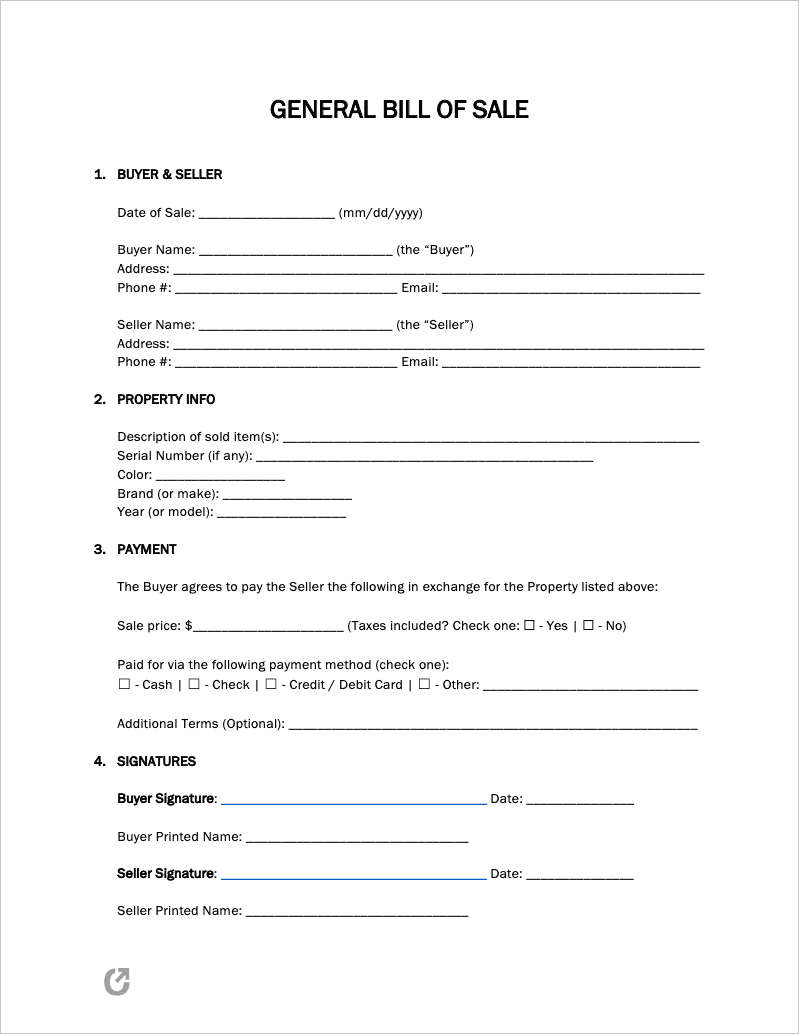General Bill of Sale Form
A general bill of sale is a form that proves a transfer of personal property between two (2) individuals occurred. It outlines the details of what happened during the transaction. The seller must sign to confirm that they are giving up ownership to the buyer. Once this happens, the buyer is liable for the item. Both parties need to keep a copy of the form to verify the change of ownership. This form is commonly used for electronics, home goods, tools, appliances, and other similar items.

By State
- Alabama
- Alaska
- Arizona
- Arkansas
- California
- Colorado
- Connecticut
- Delaware
- Florida
- Georgia
- Hawaii
- Idaho
- Illinois
- Indiana
- Iowa
- Kansas
- Kentucky
- Louisiana
- Maine
- Maryland
- Massachusetts
- Michigan
- Minnesota
- Mississippi
- Missouri
- Montana
- Nebraska
- Nevada
- New Hampshire
- New Jersey
- New Mexico
- New York
- North Carolina
- North Dakota
- Ohio
- Oklahoma
- Oregon
- Pennsylvania
- Rhode Island
- South Carolina
- South Dakota
- Tennessee
- Texas
- Utah
- Vermont
- Virginia
- Washington
- Washington D.C.
- West Virginia
- Wisconsin
- Wyoming
Table of Contents |
What is a General Bill of Sale?
A general bill of sale is a document that acts as a receipt when selling an item to a buyer. Both parties use this form for non-specific objects that do not fall into another category, such as snowmobiles, cars, or tractors. Instead, a general bill of sale is appropriate for video games, consoles, and jewelry.
When writing a general bill of sale, be sure to include the following:
- Date of Sale: The form must have the day the sale occurred.
- Contact information: The buyer and seller enter their name, address, phone number, and email to prove their identity and give others a method of contacting them after the transaction.
- Property information: By entering the serial number, color, brand, make, year, and model, anyone can locate the item if needed.
- Payment: Serves as a record of the sale price, method of payment, and tax amount.
- Signatures: Through signing, the buyer and seller agree that the information in the form is correct. Once signed, the buyer becomes the new owner of the item.
- Notarization: This section is optional as requirements vary by state. If notarization is required, the buyer and seller must wait to sign until they are in front of a notary public.
How to Sell a General Item (3 Steps)
Follow the steps listed below to prepare, list, and sell personal property to a buyer.
Step 1 – Prepare the Item
Often, sellers who prepare the item before listing receive a more significant profit and have an easier time selling. The preparation method depends on the object, age, condition, and value. For example, the merchant can increase the worth of their personal property by repainting it, replacing parts, or updating pieces. In some cases, the buyer purchases an item to fix or upgrade it themselves. Therefore, taking time to research the item and its market value can help you prepare it as needed.
Step 2 – List it
Sellers must use advertising services that attract the right audience. For example, a merchant would use a general website for items like clothes or rugs. However, they would opt for a more specific service when listing a boat. If the owner does not wish to use an online service, they can take advantage of fliers, newspapers, yard signs, and more. The list below includes methods of advertising.
- General Websites: eBay, Facebook Marketplace, Craigslist, Amazon
- Boating-Specific Websites: Boat Trader, Boats.com, Yachtworld, BoatCrazy
- Car-Specific Websites: Autotrader, Cars.com, Hemmings, CarGurus
- Other Item-Specific Websites: Rumble On, CycleTrader, Etsy, Decluttr, Gameflip
- Fliers & Newspapers
- Local Bulletin Boards
- Yard & Street Signs
In addition to posting it on the correct site, the seller must also choose a reasonable listing price. Furthermore, advertising at the right price guarantees the owner makes a fair profit. Researching prices online, using services like Kelly Bluebook, and factoring in buyer negotiation can help the seller to determine the selling cost.
After posting the advertisement, buyers will contact the seller to set up tours. At this time, the buyer may try to lower the asking price, which is something the seller should be prepared to discuss.
Step 3 – Complete + Sign Bill of Sale
After negotiating, the buyer and seller must complete a bill of sale to prove the purchase happened. Both parties must fill out the form together and sign in the presence of a notary public or witness as needed. The form must include the following information: 1) contact information of both parties, 2) the item’s description, 3) the payment method and cost, and 4) signature(s).
After signing, the former owner must officially transfer the item to the buyer, or the new owner. As soon as this step occurs, the seller no longer has authority over the item, and cannot undo the sale.
